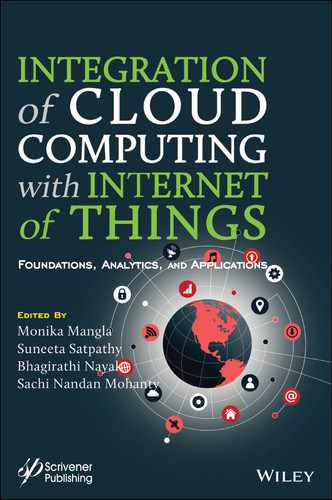The book aims to integrate the aspects of IoT, Cloud computing and data analytics from diversified perspectives. The book also plans to discuss the recent research trends and advanced topics in the field which will be of interest to academicians and researchers working in this area. Thus, the book intends to help its readers to understand and explore the spectrum of applications of IoT, cloud computing and data analytics. Here, it is also worth mentioning that the book is believed to draw attention on the applications of said technology in various disciplines in order to obtain enhanced understanding of the readers. Also, this book focuses on the researches and challenges in the domain of IoT, Cloud computing and Data analytics from perspectives of various stakeholders.
Table of Contents
- Cover
- Title Page
- Copyright
- Preface
- Acknowledgement
- 1 Internet of Things: A Key to Unfasten Mundane Repetitive Tasks
- 2 Measures for Improving IoT Security
- 3 An Efficient Fog-Based Model for Secured Data Communication
- 4 An Expert System to Implement Symptom Analysis in Healthcare
- 5 Traffic Prediction Using Machine Learning and IoT
- 6 IoT Protocol for Inferno Calamity in Public Transport
- 7 Traffic Prediction Using Machine Learning and IoT
- 8 Application of Machine Learning in Precision Agriculture
- 9 An IoT-Based Multi Access Control and Surveillance for Home Security
- 10 Application of IoT in Industry 4.0 for Predictive Analytics
- 11 IoT and Its Role in Performance Enhancement in Business Organizations
- 12 An Analysis of Cloud Computing Based on Internet of Things
- 12.1 Introduction
- 12.2 Challenges in IoT
- 12.3 Technologies Used in IoT
- 12.4 Cloud Computing
- 12.5 Cloud Computing Characteristics
- 12.6 Applications of Cloud Computing
- 12.7 Cloud IoT
- 12.8 Necessity for Fusing IoT and Cloud Computing
- 12.9 Cloud-Based IoT Architecture
- 12.10 Applications of Cloud-Based IoT
- 12.11 Conclusion
- 13 Importance of Fog Computing in Emerging Technologies-IoT
- 14 Convergence of Big Data and Cloud Computing Environment
- 15 Data Analytics Framework Based on Cloud Environment
- 16 Neural Networks for Big Data Analytics
- 16.1 Introduction
- 16.2 Neural Networks—An Overview
- 16.3 Why Study Neural Networks?
- 16.4 Working of Artificial Neural Networks
- 16.5 Innovations in Neural Networks
- 16.6 Applications of Deep Learning Neural Networks
- 16.7 Practical Application of Neural Networks Using Computer Codes
- 16.8 Opportunities and Challenges of Using Neural Networks
- 16.9 Conclusion
- 17 Meta-Heuristic Algorithms for Best IoT Cloud Service Platform Selection
- 18 Legal Entanglements of Cloud Computing In India
- 18.1 Cloud Computing Technology
- 18.2 Cyber Security in Cloud Computing
- 18.3 Security Threats in Cloud Computing
- 18.4 Cloud Security Probable Solutions
- 18.5 Cloud Security Standards
- 18.6 Cyber Security Legal Framework in India
- 18.7 Privacy in Cloud Computing—Data Protection Standards
- 18.8 Recognition of Right to Privacy
- 18.9 Government Surveillance Power vs Privacy of Individuals
- 18.10 Data Ownership and Intellectual Property Rights
- 18.11 Cloud Service Provider as an Intermediary
- 18.12 Challenges in Cloud Computing
- 18.13 Conclusion
- 19 Securing the Pharma Supply Chain Using Blockchain
- Index
- End User License Agreement
